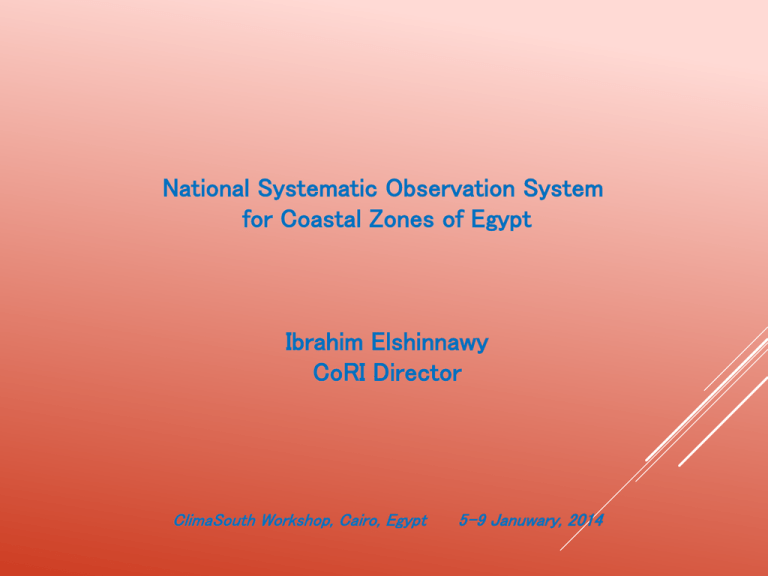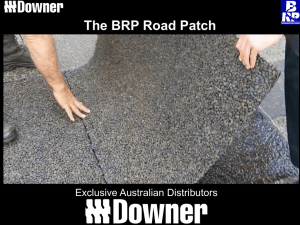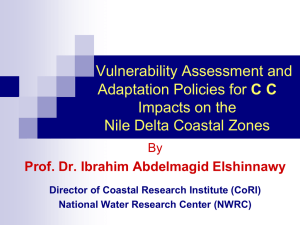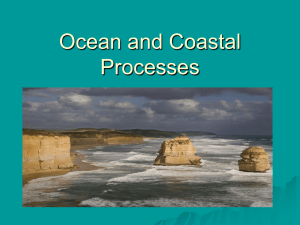National Systematic Observation System for Coastal
advertisement

National Systematic Observation System for Coastal Zones of Egypt Ibrahim Elshinnawy CoRI Director ClimaSouth Workshop, Cairo, Egypt 5-9 Januwary, 2014 OUTLINES Why the observation system Coastal Data and Observation Resources Facilities of CoRI Coastal Observation Instruments Data Way Requirements and Strategic Monitoring Forward WHY SYSTEMATIC OBSERVATION SYSTEM Importance of the coastal zones in Egypt: The Egyptian coastline, including the Sinai peninsula, extends to 3,500 kilometers. The wetlands of the Nile delta constitutes about 25% of the total wetlands area in the Mediterranean region, and produce 60% of fish catch of Egypt The coastal zones of the Red sea incorporate about one third of the national tourist income through its illustrious cities and nature WHY SYSTEMATIC OBSERVATION SYSTEM Agriculture is quite critical to the national economy Major urban centers, commerce, and industrial activities are also confined to the Nile and the coast around its delta rn Inte oad tal R oas C l na atio ^_ El Borg ^_ Baltim ^_ al on ati n r e Int tal as Co ad Ro ^_ Rosetta ^_ Ras El Bar Damietta ^_ ^_ Alexandria ^_ Kafr El Dawar ^_ ^_ Damanhour Desouk ^_ Kafr El Shaikh ^_ Mansoura Por WHY SYSTEMATIC OBSERVATION SYSTEM The coastal zone of Egypt suffers from a number of problems, including : high rate of population growth Subsidence excessive erosion rates water logging soil salinity land use interference ecosystem pollution and degradation lack of appropriate institutional management systems lack of consistent information system, Metrological and Oceanographic measurements COASTAL DATA AND INFORMATION RESOURCES Coastal Research Institute (CoRI) Protection and management Studies for shoreline and coastal systems of Egypt Accurate measurements and analysis of data for Egyptian coastal zones and coastal systems. Data Available: CoRI has a coastal database includes metrological, hydrological and hydrographic data since 1971 1900 Shoreline 1900 Shoreline 1955 1810 1909 1935 1947 1964 1988 2000 Shoreline 1964 Shoreline 1971 Shoreline 1900 Shoreline 1988 1964 Shoreline 1964 Shoreline 1990 Shoreline 1971 Shoreline 1991 Shoreline 1988 1971 Shoreline 1895 Shoreline 1988 1911 1895 Shoreline 1935 1955 Shoreline 1955 1955 Shoreline 1983 1988 1982 1992 Shoreline 1995 Shoreline 2000 1983 1991 1995 Shoreline 1996 Shoreline 2000 0 Lak 1988 1990 400 800 1000 m u eB us rull 1990 1991 1992 2000 Protec tion Sea Wall 2000 ad ved Ro Pa Light House MINISTRY OF WATER RESOURCES AND IRRIGATION NATIONAL WATER RESEARCH CENTER COASTAL RESEARCH INSTITUTE 0 400 800 1000 m 1991 1965 Shoreline 1991 1990 Grand Hotel Shoreline 1991 Shoreline 1965 Shoreline 1982 Shoreline 1992 Shoreline 1990 Shoreline 1991 Shoreline 1992 Shoreline 2000 1935 Shoreline 1911 Shoreline 1990 Shoreline 1996 Shoreline 1990 0 Shoreline Evolution at Burullus lake outlet (1810 to 2000) 200 400 600 800 m 0 400 0 800 1000 m Shoreline Evolution at Damietta Promontory (1895 to 2000) Shoreline Evolution at Baltim Sea Resort (1955 to 1990) 200 400 m GIS and Remote Sensing Unit Shoreline Evolution East of Damietta Nile Branch (From 1965 to 2000) 1996 2000 BRP 55.0 BRP 56.6 BRP 57.7 BRP 58.2 GSP 00.0 GSP 1.0 GSP 1.9 RG P 1.5 RG P 0.1 RG P 2.5 BRP 43.0 BRP 48.0 BRP 38.0 BRP 9.0 BRP 9.5 BRP 11.4 BRP 20.0 BRP 24.0 BRP 28.0 28.4 0.0 GSP 3.9 9.7 13.0 GSP GSP 28.3 5 26.8 RHP RHP 23.0 RHP 22.0 21.0 RHP RHP 20.0 .0 1 0 10 20 Hydrografic and Land Profiles Tide Gauge Stations Wave and Current Gauge Stations (S4DW) Longshore Current Measurement Stations Weather Station Water Quality Sampling Stations 30 km المحطات الحقلية واألنشطة البحثية المختلفة لمعهد بحوث الشواطئ RG P 37. 0 RG P 40. 0 .0 .0 P 49 .0 AL P 50 .0 AL P 51 .0 AL P 52 .0 AL P 53 .0 AL P 54 .0 AL P 55 .0 AL P 5657.0.0 AL PP 5859.0.0 AL P 60 AL P .0 AL AL P 61 .0 AL P 62 .0 AL P 63 AL 1 Institute Administration Bulding 2 Abu Qir Research Station 3 Rosetta Field Station 4 Burullus Field Station 5 Ras El Bar Research Station 2 GPP 0.0 RG P 32 10 RHP 0.0 AMP 15.0 P RH 5 1 P3 AL P33 AL P37 AL P2 AL 4 P1 7 AL P1 AL 9 P1 AL P9 AL P1 AL P3 AL Abu Qir Research Station Zone 3 RH 19.0 RH P 18. 0 RH P RH P 17.0 P 1516.0 .0 GPP 5.0 Time Period (Year) Shoreline Retreat Rate East and West Rosetta Mouth During The Past Century RG P 22 .0 24.8 .0 30.0 6.0 1994:1996 1991:1994 1990:1991 1988:1990 1987:1988 1983:1987 1981:1983 1971:1981 1955:1971 1942:1955 RHP RHP RGP RHP 0 RG P 20 RHP 20 GSP 4 40 RGP WBP 5.8 Ras El Bar Research Station Zone 28.3 GSP 27.0 GSP 26.4 GSP 25.4 GSP 24.4 GSP 24.1 GSP 23.1 GSP 21.3 GSP 20.3 GSP 19.3 GSP 17.9 GSP 17.0 GSP 16.0 GSP .1 WB P 6.8 WB P 9.0 WB P 10. 6 WBP 13.2 WBP 15.1 WBP 17.8 BRP 6.0 BRP 8.0 BRP 5.0 BRP 4.0 BRP 3.0 BRP 2.4 BRP 2.0 BRP 1.5 BRP 1.0 BRP 0.6 BRP 0.2 BRP 7.0 WBP 45.0 WBP 50.0 WBP 35.0 WBP 21.7 WBP 25.0 30 60 WBP 30.0 P 4.1 4.6 5.7 WB P RH P 2.9 80 WBP 100 WBP 120 WBP 40.0 West of Rosetta Mouth East of Rosetta Mouth BRP 13.0 BRP 13.4 BRP 14.8 BRP 16.5 Burullus Field Station Zone Rosetta Field Station Zone Shoreline Evolution at Rosetta Promontory (1900 to 2000) 160 140 WBP 62.6 WBP 61.6 WBP 60.6 WBP 59.9 WBP 58.6 WBP 57.6 WBP 56.8 200 180 WB Shoreline Retreat (meter/Year) 1922:1942 Responsibility: 1909:1922 1898:1909 COASTAL DATA AND INFORMATION RESOURCES Egyptian National Oceanographic Data Center (ENODC) Responsibility: Receive, Prepare and maintain data observed by NIOF-branches as well as the available oceanographic and weather data from Meteorological Agency, Fisheries Agency, Universities and other organization in Egypt. Data Available: Checklist of Egyptian Mediterranean and Red Sea Fishes. Tides at Alexandria, Egypt, for the period 1993-2000. Hydrographic studies of some lagoons near Hurgadda. Current System Survey at Exploratory drilling site Hurgada-Red Sea. Topography, tides and physio-chemical characteristics of Sinai. Concentrations of the major ions in sea water of deferent salinity. Physical Oceanography data for Red Sea (1990-2000). Circulation models applied on the eastern Mediterranean Sea. A comprehensive bibliography of the physical oceanography of the Mediterranean Sea. COASTAL DATA AND INFORMATION RESOURCES National Authority for Remote Sensing and Space sciences (NARSS) Responsibility: NARSS is mainly aiming at promoting the use of the state of the art of space technology and Earth observation for the sustainable development of Egypt and introducing high technological capabilities into the local and regional market. Data Available: Data provided by earth observation satellites and various airborne sensors Produce maps and spatial data for the evaluation and monitoring of natural resources and natural hazards. COASTAL DATA AND INFORMATION RESOURCES Ministry of petroleum and Egyptian Petroleum Research Institute (EPRI) Responsibility: Develop studies and applications within the Oil sector, and to find solutions to both long and short terms Oil sector’s technical problems. Data Available: Metrological and oceanographic data of the Mediterranean and Red sea petroleum platform’s sites. COASTAL DATA AND INFORMATION RESOURCES Egyptian Environmental Affair Agency (EEAA) Responsibility: Formulating environmental policies. Preparing the necessary plans for Environmental protection and Environmental development projects, following up their implementation, and undertaking Pilot Projects. The Agency is the National Authority in charge of promoting environmental relations between Egypt and other States, as well as Regional and International Organizations. Data Available: Monitoring Program (EIMP) aims at establishing national environmental monitoring program for ambient air and coastal waters. (http://www.eeaa.gov.eg/arabic/main/achivements.asp) EEAA is responsible for collecting the EIA studies for all new projects within the coastal zone. These studies have value metrological and oceanographic data. COASTAL DATA AND INFORMATION RESOURCES Shore Protection Authority (SPA) Responsibility: Responsible for managing the shoreline in coastal areas that are threatened by erosion. Developing shorelines management plans Designs projects for shore protection. Issues license for projects to be located in the set-back area according to existing laws and regulations. Data Available: SPA has a monitoring program during construction and assessment of the coastal structures. COASTAL DATA AND INFORMATION RESOURCES Egyptian Naval Forces, Hydrographic Department (ENHD) Responsibility: Responsible for the production of navigation charts for Egyptian territorial waters in the Mediterranean and Red Sea. Data Available: ENHD works closely with the International Hydrographic Organization (IHO) and the International Maritime Organization (IMO). The department of Oceanography and Meteorology operates wave, current and tide gauges in the Red Sea and Mediterranean. COASTAL DATA AND INFORMATION RESOURCES Survey Research Institute (SRI) Responsibility: Adapt, develop, and incorporate modern methods of computer-aided field surveying and data processing with the aim of accelerating the production and updating different types of maps to serve as a central organization in developing and applying all modern aspects of geodesy; photogrammetry, remote sensing, geodesy and geographic information systems. Data Available: SRI has a monitoring program for the sea level changes along the Mediterranean and Red sea for recent years with the cooperation of marine forces. COASTAL DATA AND INFORMATION RESOURCES Egyptian Ports Authority (EPA) Responsibility: Management of Ports, Data Available: EPA has a monitoring program for the metrological and oceanographic parameters within the Egyptian harbors and ports COASTAL DATA AND INFORMATION RESOURCES Egyptian Metrological Authority (EMA) Responsibility: Responsible for providing the meteorological facilities and services for the Egyptian Authorities, international marine navigation and international air navigation Data Available: EMA has a large database for the metrological data. COASTAL DATA AND INFORMATION RESOURCES Data Exchange Challenges The national plan for data collection is not established yet. This situation causes many problems such as: Lack in data collection standardization. Lack in data exchange system. Lack in information about the available data and its sources. Duplication in collecting the same data which cause loss of money and time. To solve these problems, it is recommended to establish a Climate Data and Information Center (CDIC). The objectives of this center are: Acquisition, processing, quality control, inventory, archival and dissemination of data and data products responsible for international climate data exchange. Providing data and information services in real-time. AVAILABLE FACILITIES AT COASTAL RESEARCH INSTITUTE The Coastal Research Institute hosts five well-equipped laboratories in Sedimentation Oceanography water quality physical model Database MAIN AVAILABLE EQUIPMENTS AT COASTAL RESEARCH INSTITUTE Instrument Description Efficiency Operation Cost/ Unit /Year (L.E) Repairing Cost/ Unit Insurance Cost/ Unit (L.E) Units Numbers Very old and using drawing Chart 200 150 - 6 Mari graph Measuring sea Level Andera Direct reading Current Speed and Direction Working Good 300 100 - 4 Current Meter (CM2, SM2) Direct reading Current Speed and Direction Working Good 60 150 - 3 Wind Station Measuring Wind Speed and Direction Working Good 300 200 - 2 S4DW Measuring Wave Characteristics. Not working and need maintain-nce 20000 5000 20000 4 Wave Rider Measuring Wave Characteristics Not working and need maintain-nce 20000 10000 20000 1 Marine System (Computer, DGPX , Echo Sounder, Marine Survey Outboard Motor and Rubber Boat)) Working Good 5000 3000 - 5 Total Station Land Survey Working Good 2000 1500 - 2 Precise Leveling Measuring Land Level Working Good 200 200 - 5 COASTAL OBSERVATION INSTRUMENTS In order to define Coastal Observation Instruments the following issues must be considered: Climate data needs are different to those data needs that support other activities of national coastal observation services. Its important to maintain data quality, security, homogeneity and continuity in long-term that are essential for detecting and monitoring climate change. The issues of data rescue and quality control are two particularly relevant issues in this regard. Expanding ocean and atmosphere observations scope and scale is essential to improved understanding, modeling and predicting of the ocean and climate COASTAL OBSERVATION INSTRUMENTS A. To consider such issues, the following equipments are required: Oceanographic and Metrological data Acquisition Buoys (3 stations) Water Temperature Wave Height and Direction Current Speed and Direction Tidal Trends Salinity Turbidity and PH Wind Speed, Direction and Gust Barometric Pressure and Air Temperature. COASTAL OBSERVATION INSTRUMENTS B. Hydrographic Survey System (2 systems). Duel frequency Echo sounder for shallow water area, range from 0.5 to 50 m depth WASS and Deferential enable GPS Sound velocity meter Marine computers Hydrographic survey software for surveying and data analysis COASTAL OBSERVATION INSTRUMENTS Models Coastal Research Institute staff developed SIMCOPRO and ImSedTran models Simulating coastal processes (SIMCOPRO) is a 2-D model simulating the distribution of currents, waves and sediment transport. Implicit sediment transport (ImSedTran) is a 2-Dmodel Simulate the distribution of the wave and determine breaking characteristic, taking into consideration the influence of existing ridges and contour line. In addition CoRI researcher used the free One-line models GENESIS to estimate long-shore sand transport rates and long-term shoreline changes. CoRI researchers need training on MIKE 21 2-Dimensional Wave model and Litpack main modules DATA REQUIREMENTS AND STRATEGIC MONITORING A. Observation plan is urgently needed for measuring metrological and oceanography parameters which have a great impacts on coastal zone. Inshore zone: Periodic land survey of hydrographic profiles distributed along the study area two times per year. Recording wind speed and direction. DATA REQUIREMENTS AND STRATEGIC MONITORING B. Near shore zone: Periodic survey of hydrographic profiles distributed along the study area two times per year. Recording the variation of sea level. Daily measurements of long-shore current in the critical areas. Measuring current beyond breaker zone, two times per year. Measuring current in the outlets of the lakes (daily). Collecting surface bottom samples from the seabed, times per year. Measuring temperature, salinity, two times per year. two DATA REQUIREMENTS AND STRATEGIC MONITORING C. Offshore zone: • Recording wave height, period and direction. • Recording current speed and direction. • Recording weather parameters: air temperature, wind speed & direction, …etc. CONTINUOUS OBSERVATION WOULD PROVIDE: Bathymetric surveys Topographic surveys Aerial surveys Lidar surveys Ecological mapping Hydrodynamic data collection Analytical services WAY FORWARD Main problems are: No data and information exchange Insufficient budgets and funds Capacities No Coordination No Cooperation No Integration The main questions are: Who makes what, How, Where & for how long…? Where are the gabs (types, locations, frequencies, analysis)? Who would take the lead to initiate coordination that results in cooperation that reaches the integration? Thanks to You All








